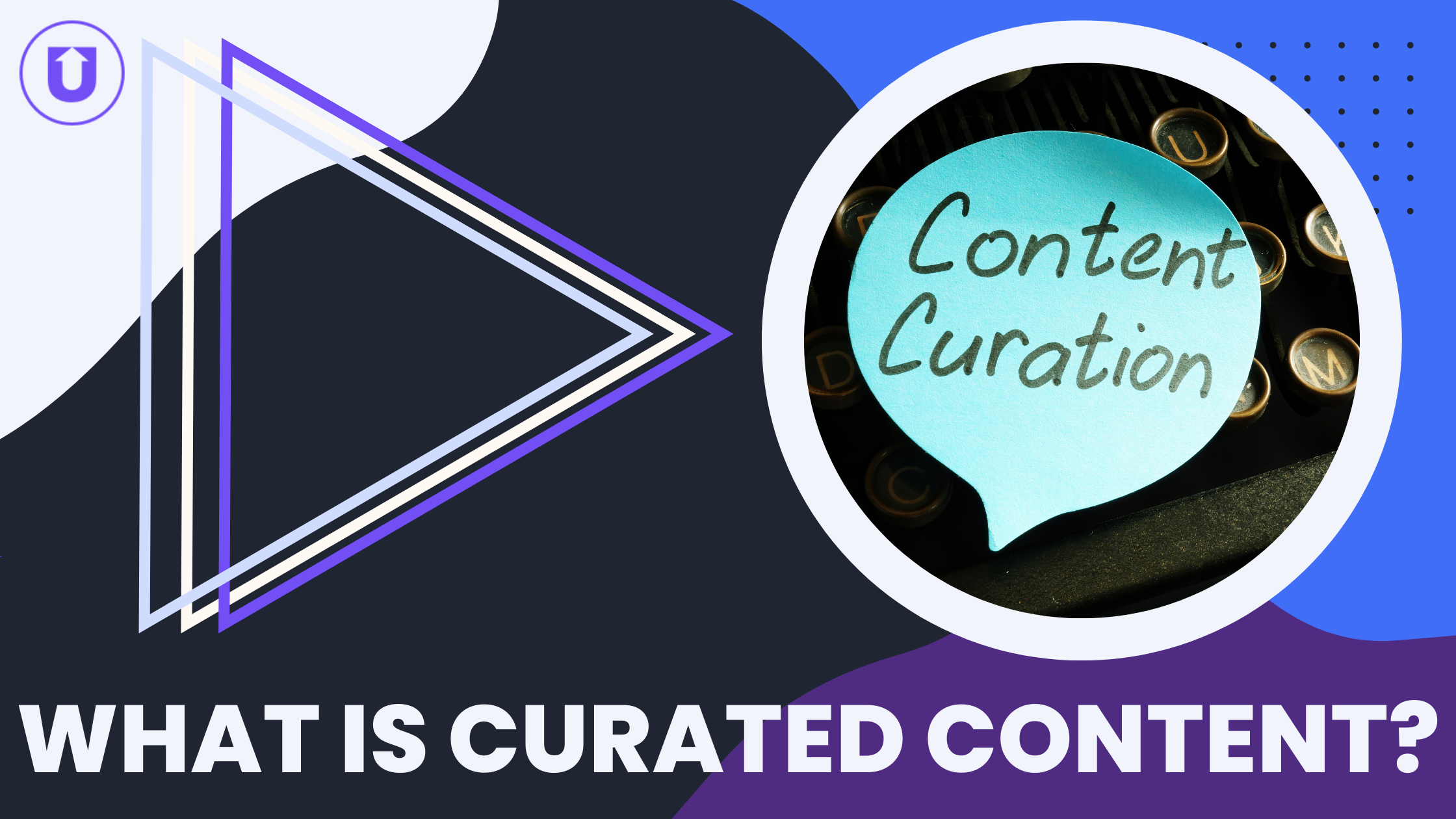What is Curated Content?

If you’re not curating content yet, you’re missing out on a great way to demonstrate your thought leadership.
No amount of blog writing, viral TikTok dances, or graphic design has completed your content goals of engaging your audience and [insert your other goals], but mixing in relevant curated content may be the secret ingredient you’ve been looking for.
A curated content strategy uses authoritative third-party articles, pieces you didn’t write, to open up a relationship with a new individual or audience because you’re providing something without asking for something in return.
I know, that sounds scary at first.
Shouldn’t there be a call to action in every piece we put in front of our customers?
What if they don’t go with my product because I didn’t push them to a demo or opt-in form?
We understand. That’s a scary mental block to break through, but it is just that.
If you’re not establishing trust with your potential customers even before they are ready to buy as well as maintaining that trust after their purchase of engagement with you, they will turn into frustrated customers down the road - looking elsewhere for that magic they once had with you.
As a prospect or current customer, we get it. You’re awesome, but in order to stay engaged with your brand, we’re starving for more.
What are you reading, what are your thoughts on what others are saying and the current events in the industry?
Those same analog conversations you have over the phone, over a meal, or in email with a customer or client are the insights your digital audience craves - and you don’t need to start from scratch to share them.
That’s where content curation can help. It’s a springboard for sharing your insights.
Here at UpContent, we know how hard it is to constantly feed the interweb’s belly with content.
We created the now highest-rated content curation solution because we wanted to help other sales reps, HR teams, and marketing strategists succeed and succeed efficiently.
So let’s take a deep dive into curated content, shall we? By the end of this article, you’ll know the difference between curated and created content, why you should be creating AND curating, how to go about it, and if you have to hire someone to do it!
The difference between curated and created content
Curated and created content are both valuable ways to promote your business but neither can stand on its own, let’s take a closer look at both content approaches!
Curated Content
The short answer is that curated content is somebody else’s content that you’re sharing with your audience.
This is an example of curated content: “Hey, Bethany. Here’s a great article that I think is impactful about gnomes, and I think you should read.”
Created Content
Created content can be literally ANYTHING that you create! It could be a blog, an article, a graphic, a video, or any piece of content you build from the ground up is content creation.
Created content looks like this: “Hey Bethany! Check out this article about gnomes that I wrote, and I think you should read.”
Why you still need to create your own content
Studies have shown that curated content receives 33% more engagement than created content on social media.
However, the same article points out that created content has a 54% higher click-to-conversion rate when it points to your website.
Curated content brings people in, but there needs to be something else there to capitalize on what the curated content has done.
Tell the full story with curated content
Content curation is not about replacing your original thought leadership. And it’s not about sharing somebody else’s stuff to give them more reach.
It’s about putting everything together to better tell your story about what you know and do best, providing context to what you’re saying.
You’re educating your audience without asking for anything in return, allowing them to see you as the ultimate source for insight, the place to always get the good stuff, no matter who created it.
When you share articles from other people that are also saying the same thing as you, people won’t feel like they have to go and research it anywhere else.
It shortens the decision period if they’ve already read everything on your website that they would have researched.
By making someone feel like they have free range, even though it’s still within your “fenced-in yard,” a.k.a. your blog, they can’t see the fences because you’re putting other content in there as well.
They feel like they are making their own decision while you’re silently helping guide that decision without being too pushy or salesy.
And that access point is what makes curation work.
Whether it’s marketing, whether it’s sales, whether it’s a person looking for their next job, right?
Because we’re all inherently lazy. And so if you can give people the answer in a way that they could trust, they can move on to the next thing on their checklist. That’s awesome.
We’ve yet to encounter anyone who has said, “Oh, you helped me too much. Now I still want to go and do other stuff.”
How you should be curating content
Technically you can curate any content out there that’s been created and shared on the internet.
But this doesn’t mean you should share any kind of content out there.
Here at UpContent, we strategically focus on curating text-based content for two main reasons.
Keep it legal
The first reason is more tactical from a legal perspective. NEVER hinder the reader’s access to the original article you’re curating from.
That’s a key test of Fair Use, which means if you’re going to use somebody else’s stuff, don’t circumvent their need or ability to get to where that stuff lives.
Provide full context
When sharing images or videos, it can be challenging to provide the full context surrounding that type of content versus text-based content.
Where should I send you as the reader if I’m pulling an image and not providing context as to why I’m pulling that image and curating that? Do I send you to the image URL that shows only the image there and nothing around it?
It seems kind of jarring, doesn’t it?
It’s the same as copying and pasting an article from another publisher without linking to the original article.
If I move the image and put it on my site, it doesn’t support the creator of that content and, therefore, could put me into a lot of legal hot water.
It also is, in our view, not a way to build trust then, right?
So you come into my site, I’ve got all this great, all this fantastic imagery on there that I’m taking you to, and you’re like, “Wow, this is cool!”
And then on a bar in the bottom corner. I say, “I didn’t create this somebody else did.”
How does that make you feel?
It cheapened my credibility and made you less likely to trust me when I say, “I did create this!” Because if I’ve borrowed imagery without properly crediting before, what would stop me from that?
TLDR: Video and graphics are best for content CREATION, while text-based articles and blogs are great for your content CURATION strategy!
Do you have to hire someone to do this?
No!
We promise we aren’t contradicting ourselves here.
Yes, content curation is essential to your marketing strategy, but that doesn’t mean you should be curating SO MUCH that it creates the need for an extra person on your marketing team.
What’s most important is that your curation efforts are NOT siloed from the rest of your content strategy.
Content curation does not replace a content manager or strategist.
For a small team, the person who should be curating is the person who’s running the show, who’s delivering the solution, and who’s helping to sell those deals because they know what’s happening in the industry.
And they’re probably the ones most likely to be reading those industry publications or industry-related articles anyway.
So instead of them just reading it, thinking, “Oh, that’s cool,” and then picking up the phone and doing the next sales call, they should be recommending content for the marketing department to massage and orchestrate the distribution and tie it to an original piece of content.
An easy way for your sales reps or other in-charge personnel is to use content curation software like UpContent or Pocket that will select the best and most relevant content for your business, and they can choose which ones the marketing department should share.
So what should I do with curated content?
Now that you know what curated content is, why you should include curated content in your marketing strategy, and how you should be sharing it, check out Seven Ways To Use Curated Content for some ideas on how your business can immediately start curating!
Curation allows for that openness or the ability to start a dialogue without throwing your stuff in somebody else’s face.
It doesn’t replace the need for original content, but it allows you to become a consistent access point for related content to your niche without creating mediocre content.
Just be mindful when sharing someone else’s content and ensure your reader understands it’s curated and can read the original content easily!
Content curation doesn’t have to be complicated.
It can be an extra 20 minutes of your time a week, then ship the amazing content you found to your marketing team for them to work their magic or find a tool that already integrates with your current content distribution channels to get even more from the time you already spend staying on top of your industry.
Teamwork makes the dream work!



